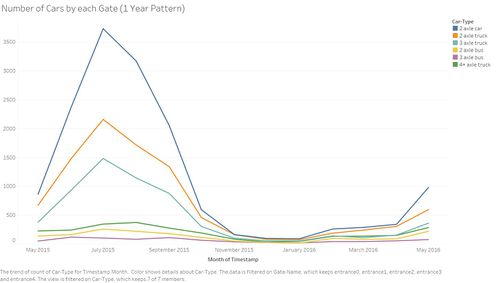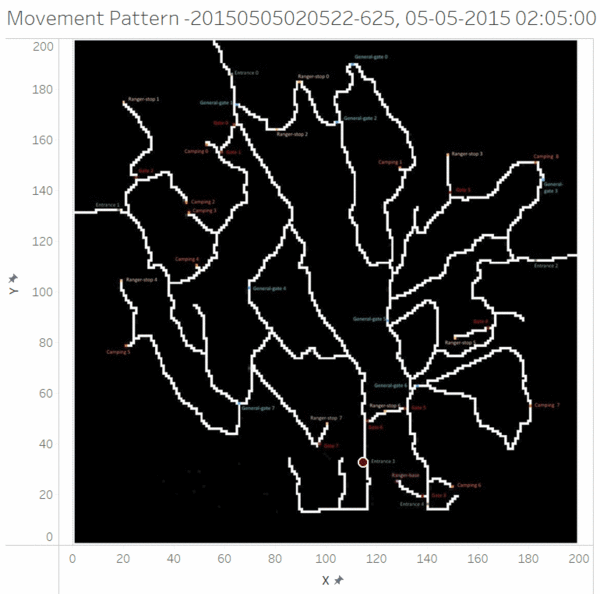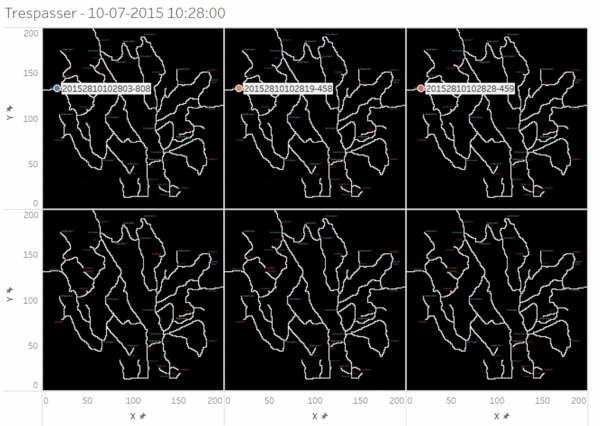Difference between revisions of "ISSS608 2016-17 T3 Assign SANDEEP CHALLA"
| Line 78: | Line 78: | ||
<div style="padding-left:10px; text-align:left"> | <div style="padding-left:10px; text-align:left"> | ||
<font size = 2; color="#070002">''' Pattern 4'''</font> | <font size = 2; color="#070002">''' Pattern 4'''</font> | ||
| − | </div | + | </div> |
From the features that I have calculated I have noticed that there were as many as 1580 vehicles consisting of all types of vehicles, which used the park as a bridge to get to the other side of the preserve at different times of the day. entrance 2 <---> entrance 4 and entrance 0 <---> entrance 3 were connected by the park. Similarly, there were also other vehicle id's which had as low as 3 trips which again means they could be using the preserve as a bridge. Technically for a person to camp, he should have at least 4 stops entrance > camping > camping > entrance. | From the features that I have calculated I have noticed that there were as many as 1580 vehicles consisting of all types of vehicles, which used the park as a bridge to get to the other side of the preserve at different times of the day. entrance 2 <---> entrance 4 and entrance 0 <---> entrance 3 were connected by the park. Similarly, there were also other vehicle id's which had as low as 3 trips which again means they could be using the preserve as a bridge. Technically for a person to camp, he should have at least 4 stops entrance > camping > camping > entrance. | ||
Revision as of 02:51, 17 July 2017
Contents
About the VAST Challenge
The Visual Analytics Science and Technology (VAST) Challenge is an annual contest with the goal of advancing the field of visual analytics through competition. The VAST Challenge is designed to help researchers understand how their software would be used in a novel analytic task and determine if their data transformations, visualizations, and interactions would be beneficial for particular analytic tasks. VAST Challenge problems provide researchers with realistic tasks and data sets for evaluating their software, as well as an opportunity to advance the field by solving more complex problems.
Researchers and software providers have repeatedly used the data sets from throughout the life of the VAST Challenge as benchmarks to demonstrate and test the capabilities of their systems. The ground truth embedded in the data sets has helped researchers evaluate and strengthen the utility of their visualizations.
The VAST Challenge 2017 presents three mini-challenges and a grand challenge for you to apply your visual analytics research and technologies to help a sad state of affairs in a wildlife preserve.
These challenges are open to participation by individuals and teams in industry, government, and academia. We encourage your submissions and look forward to seeing your innovative approaches to solving these challenges using visual analytics.
Overview
Mistford is a mid-size city is located to the southwest of a large nature preserve. The city has a small industrial area with four light-manufacturing endeavors. Mitch Vogel is a post-doc student studying ornithology at Mistford College and has been discovering signs that the number of nesting pairs of the Rose-Crested Blue Pipit, a popular local bird due to its attractive plumage and pleasant songs, is decreasing! The decrease is sufficiently significant that the Pangera Ornithology Conservation Society is sponsoring Mitch to undertake additional studies to identify the possible reasons. Mitch is gaining access to several datasets that may help him in his work, and he has asked you (and your colleagues) as experts in visual analytics to help him analyze these datasets.
Mini Challenge 1
The Boonsong Lekagul Nature Preserve is used by local residents and tourists for day-trips, overnight camping or sometimes just passing through to access main thoroughfares on the opposite sides of the preserve. The entrance booths of the preserve are monitored in order to generate revenue as well as monitor usage. Vehicles entering and exiting the preserve must pay a fee based on their number of axles (personal auto, recreational trailer, semi-trailer, etc.). This generates a data stream with entry/exit timestamps and vehicle type. There are also other locations in the part that register traffic passing through. While hiking through the various parts of the preserve, Mitch has noticed some odd behaviors of vehicles that he doesn’t think are consistent with the kinds of park visitors he would expect. If there were some way that Mitch could analyze the behaviors of vehicles through the park over time, this may assist him in his investigations.
Data Preparation
I used the Tableau and Power BI for data viz and Excel for cleaning the data, and generating other features.
- Tableau
- Power BI
- Excel
Above provided is a screenshot of the final list of features before the data viz which I feel are important and the features were calculated in Excel. "gate-name2" indicates the gate to which the vehicle has headed from the gate in the column "gate-name1" which was available in the raw data. Time-taken or time-spent is the measure of time taken for different vehicles to travel from one gate to other indicated in seconds, time spent at each camping site was also calculated. Time taken was calculated to evaluate the speed of the vehicles which is one of the important aspects of this challenge. Other prominent features that were calculated are "number of stops" which indicates the number of gates visited on one particular trip. Another important feature that was generated was a flag variable to indicate whether the vehicle visited a camping location or not.
Since the coordinates for the sensor locations were not available, it was generated using annotate feature in tableau. The map was loaded as a backgraound image of a scatter plot while defining the boundaries at (0,0) and (200,200). The point was selected on the map and then the x and y coordinates were selected. Likewise every other point on the map is selected.
Question 1
“Patterns of Life” analyses depend on recognizing repeating patterns of activities by individuals or groups. Describe up to six daily patterns of life by vehicles traveling through and within the park. Characterize the patterns by describing the kinds of vehicles participating, their spatial activities (where do they go?), their temporal activities (when does the pattern happen?), and provide a hypothesis of what the pattern represents (for example, if I drove to a coffee house every morning, but did not stay for long, you might hypothesize I’m getting coffee “to-go”).
Pattern 1
| Vehicular traffic at each gate type is plotted. It is observed that the traffic was peak between 5AM and 7PM at gate types camping, entrance, ranger stop and general gate, general gate being the highest. It can also be observed that only the park vehicles labelled 2P had access to the gates which lead to ranger base, and hence the traffic at these locations was comparatively less. General gate which was located at different locations in the preserve is well used by all vehicles. |
Pattern 2
| It is observed that the vehicular movement to and from the camping areas is only in the time from 5AM to 10PM. This is probably not to disturb the animals in the preserve during the night. There is one exception which will be discussed in the corresponding section. Only car-types 2-axle-car, 2-axle-truck, 3-axle-truck are allowed in the camping areas apart from the park vehicles which has unrestricted access to all the regions of the park. |
Pattern 3
Vehicle density is plotted for different days of the week. It was observed that the vehicles which had access to camping areas had high vehicle density as compared to other vehicles. It was also observed that there were more vehicles during weekend i.e. saturday and sunday as compared to other days of the week.
Pattern 4
From the features that I have calculated I have noticed that there were as many as 1580 vehicles consisting of all types of vehicles, which used the park as a bridge to get to the other side of the preserve at different times of the day. entrance 2 <---> entrance 4 and entrance 0 <---> entrance 3 were connected by the park. Similarly, there were also other vehicle id's which had as low as 3 trips which again means they could be using the preserve as a bridge. Technically for a person to camp, he should have at least 4 stops entrance > camping > camping > entrance.
Question 2
Patterns of Life analyses may also depend on understanding what patterns appear over longer periods of time (in this case, over multiple days). Describe up to six patterns of life that occur over multiple days (including across the entire data set) by vehicles traveling through and within the park. Characterize the patterns by describing the kinds of vehicles participating, their spatial activities (where do they go?), their temporal activities (when does the pattern happen?), and provide a hypothesis of what the pattern represents (for example, many vehicles showing up at the same location each Saturday at the same time may suggest some activity occurring there each Saturday).
Pattern 1
| The frequency of vistors is not the same all the year round. Similar tres has also been observed for vehicles passing through the preserve i.e. the vehicles that are using the preserve just to enter through an entrance and leave through another entrance. July is the time most of the visitors come to the preserve, April to October is the time when the Preserve is relatively busy compared to other months of the year. |
Pattern 2
| Chord diagram shows the number of vehicles moving from one gate to another. It is seen from the chord diagram that ranger stop 1 to ranger stop 2 is the most popular route.
general-gate2 >> ranger-stop0 - 7490 ranger-stop0 >> general-gate2 - 7311 ranger-stop0 >> ranger-stop2 - 7463 ranger-stop2 >> ranger-stop0 - 7284 ranger-stop2 >> general-gate1 - 7427 general-gate1 >> ranger-stop2 - 7248 general-gate4 >> general-gate7 - 5508 general-gate7 >> general-gate4 - 5312 general-gate4 >> general-gate1 - 4096 general-gate1 >> general-gate4 - 3933 general-gate5 >> general-gate2 - 3976 general-gate2 >> general-gate5 - 3971 These are the routes taken by the vehicles for travelling in the park. |
Pattern 3
I also analysed the camping preferences of the visitors. It is found that the camping site 1 is the least preferred site with less number of people visiting and also spending less time on that particular site. camping sites 4, 5, 6, and 8 are the most popular camps and it is also the camps in which visitors are spending more time compared to other camps.
Pattern 4
I have analysed the top 25 routes taken by different vehicle types and was surprised to find one thing that the minimum time taken by the vehicles for different types of vehicle were almost the same, with a difference in few seconds. This indicates that the vehicles irrespective of their size 2 axle, 3 axle, 4 axle or 4+ axle might going above the speed limit of 25 mph. Naturally bigger vehicles with more number of axles make more noise when going at such speeds..
Question 3
Unusual patterns may be patterns of activity that changes from an established pattern, or are just difficult to explain from what you know of a situation. Describe up to six unusual patterns (either single day or multiple days) and highlight why you find them unusual.
Pattern 1
| The car with ID 20155705025759-63 has never left the park. This car was in park since 5th June, for 360 days. This person has not left the preserve and spends around one month at each camping site he goes. He is either parking the vehicle at one place and travelling by foot or spending time near the camp. His intentions are not clear from this. |
Pattern 2
| There have been a total of 11 vehicles which made multiple trips to the park out of which the six vehicles are of type 4 which essentially means that they are 4+ axle truck or bus. These trips cannot be considered as multiple trips because the vehicles have come in for a duration of 5-6 seconds and left the park and were made to wait outside for a duration of 11-12 hours. Since it is 4+ axle vehicles, these are probably some security checking being done before entering the preserve. The vehicles of other types which made multiple trips followed the same pattern every time they visited the park.
The vehicle with id 20153712013720-181 visited the park on 4 consecutive Sundays and left on Tuesday 12th July to 2nd August, and every time he visited camping site 6. The vehicle with id 20154112014114-381 visited the park on 7 consecutive Fridays and left on Sundays 12th June to 24th July, and every time he visited camping site 6 and the time visited by this vehicle 20154112014114-381 overlapped with the car id 20153712013720-181. The Vehicle with id 20154519024544-322 visited the park on 16 consecutive Fridays and left on Mondays from 19th June to 2nd October, and every time he visited camping site. The vehicle with id 20162904122951-717 visited the park on 6 consecutive Fridays and left on Sunday from 4th March to 8th April, and every time he visited camping site 0. All these vehicles took the same route everytime they visited the preserve. The vehicle with id 20162027042012-940 visited the park three times and camped at site camping site 1. |
Pattern 3
| A total of 23 vehicles of type 4+ axle had entered ranger-stop 3, might be for a specific purpose. This vehicle is enterign the park almost everymonth might be get some supplies for the rangers. |
Pattern 4
| On 10th July 2015, these six vehicles arrived at 10.30 AM and have probably trespassed into the ranger-stop 1. They reached ranger stop 1 within the next 5 minutes without passing via Gate 2. This implies either the sensor at gate 2 must have failed to capture these data or most probably they have found another route to reach this destination. Though they reached the spot together, they returned back to the entrance separately after every 40 minutes to 1 hour break. It seems that as they did not return together but individually, they are most likely not be visitors. |
Conclusion
The top 3 patterns I have identified that could be impactful to the bird life in the nature preserve are
- The 2 axle and 3 axle buses are frequently using the nature reserve as a bridge at all times, particularly this could disturb the habitat of animals.
- The trucks, especially 3 axle and 4 axle trucks, could be causing more trouble to the flora and fauna due to the noise and pollution made by these heavy vehicles.
- The night campers are also suspected to be a reason for the disturbance of the bird life in the Boonsong Lekagul Nature Preserve.
Comments & Feedback
Please check discussion tab for comments and feedback.
















